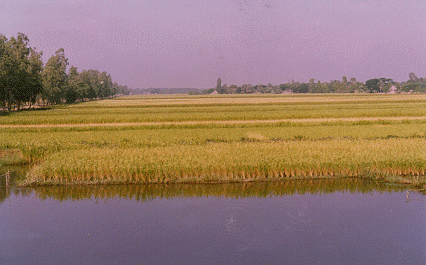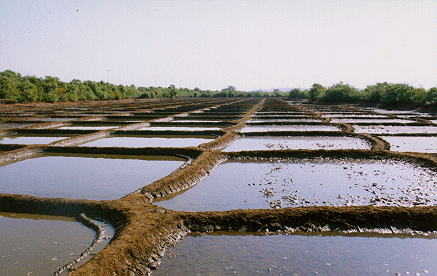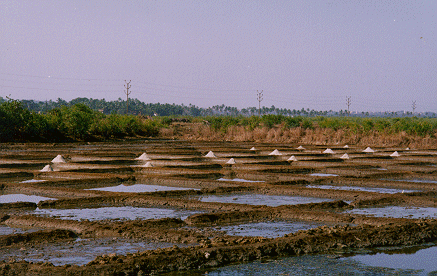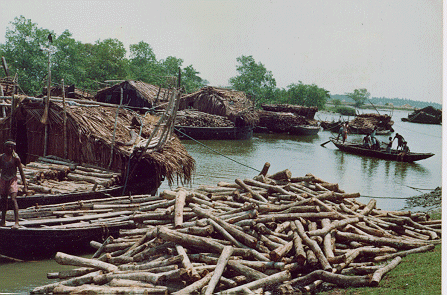| Mangroves Ecosystem of India |
The mangroves are fragile complex and dynamic ecosystem, and are dependent on the following inter-related, environmental both, biotic and abiotic factors :
Climatic factor
Climate of any inter-tidal region acts as the most significant and important factors for natural growth, development and succession of the mangroves. Among these climatic factors
Atmospheric temperature fluctuation ranges between 20 c and 35
Rainfall
Regular wind flow
Frost free
Radiation
Sedimentation play very dominant role for the mangrove viability in a holistic manner.
Temperature : Among these basic
climatic factors, the air temperature of the region may be governed by
the geographic distribution of the different species of mangroves.
Atmospheric temperature fluctuation ranges
between 20 c and 35
Rainfall
The rainfall conditions are more decisive for the sequence of mangrove distribution of the different zone in the tidal regions. The rain water leaches down the saline soil or salt particles, within the soil strata more effectively. During the successive tidal flood the salt water inundate the land surface and the subsequent exposure of the soil substratum evaporate the water from these salt mixed solution. These results thick salt crust on the soil surface and these salt crust check the regeneration and growth of the mangroves. Frequent rain water flashing wash out the surface salt and also leach down the salt particles and make the land suitable for the growth of the mangrove.
Mangrove develop best in the region, experiencing abundant rainfall, evenly distributed throughout the year and when the climate is very much regular.
The Indian subcontinent is a typical tropical zone. The coastal climate is generally uniform except Gujarat coast which experiences drought conditions. The Indian coast is influenced by two monsoon cycles, viz. Southwest and northeast. The monsoon rainfall varies from 3,600 mm along the Kerala coast and decreases further towards Gujarat coast in the north to a bare minimum of 400-600 mm. The Kuchchh region receives very scanty rain. Along the east coast, major precipitation is experienced from September to December.
Along the east coast, the rainfall variation is different from the west coast. The Gulf of Manner receives less than 90 mm rainfall which increases gradually towards the north of Porto Nova upto 1,500 mm and in the Sundarbans forest upto 1,908 mm. The Andaman and Nicobar Islands experiences very heavy rainfall upto 3,200 mm during a year.
Wind
The wind flow may have the drying power of the air and its mechanical effect may cause damage to the mangrove plants and its ecosystem.
The Sundarbans mangrove forest have
several cyclone hits, arising from the bay of Bengal. The destruction of
mangrove plants and ecosystem have been experienced during the last two
centuries. Several cyclones have affected the mangrove forests. The coastal
zone of the Sundarbans are funnel shaped in its coast line and every year
4-5 cyclonic storms are common in the mangrove forests of Sundarbans.
Soil
The soil structure and soil salinity
are the main agents, controlling the distribution of mangroves.
Along the Indian coast and major groups
of islands, large variations exist in the soil of mangrove forests. The
Andaman-Nicobar Islands are volcanic in nature and the geology is complex.
These islands are characterized by the diversity of sedimentary rocks mainly
composed of sandstone's. Locally, conglomerates or calcareous rocks are
found. The Gangetic Sundarbans has deposition of alluvial soil brought
by the river flow.
The soil from Cauvery delta is classified under saline hydromorphic soils, with little humus, while the soil in Pichavaram mangrove consists of fine and coarse silt, with 20 to 30% clay, 10 to 20% silt, 45% fine sand and 15% coarse sand.
The soil of the Cochin backwaters in Kerala represents typical lateritic rocks. The soil surface is fully covered with decomposing plant material, followed by a dark gray soil with litter sand. This soil is very acidic.
The Goa coast soil shows predominantly a mixture of lateritic rock and clay, while the Bombay region is characterized by basaltic traps.
The Gujarat coast has fine silt and
clay mixed with soft sandstone which is found along this coast.
In India, the different mangrove species
show tolerance for particular range of salinity of the surface waters as
well as interstitial water.
In Saurashtra and Kutchchh region, where soil salinity is very high the mangrove species are dwarf in habit.
Most of the floral elements of mangrove forests are generally observed in the prohaline and mesohalline region. However, Nypa fruticans, Heritiera spp., Sonneratia caseolaris, Acrostichum aureum, species of several sedges and grasses are only found growing in the oligohaline region.
The soil salinity of the supralittoral zone, where water reaches once or twice in a month during highest high-water tide, is comparatively high because of the rate of evaporation. In such regions, species like Suaeda maritima, Salicornia brachiata, Clerodendron inerme. Which are scrubby type, are predominant.
Tidal Amplitude
The tidal fluctuations has the major
role for mangrove habitats, as most mangroves grow well in between the
Mean High Water Spring Tide (MHWST) and Mean Sea Level (MSL)
Along the west coast, the tidal amplitude
changes from south to north. At the southern most tip of India (Kerala),
tidal amplitude is minimal. However, at Goa this difference is about 1.5
to 2 meters. In the Gulf of Khambhat the highest tidal amplitude is about
8-9 m, while in the Gulf of Kuchchh it is around 5 meters. These are regular
high tides which are also known as 'tidal bore'. Along the west coast,
differences between the ‘tidal bore’ is seen in Hoogly River, particularly
during cyclonic conditions.
Tides are also affected by freshwater
discharge, particularly, floods during monsoon seasons.
Flora and Vegetation
The Indian mangroves comprise approximately 59 species in 41 genera and 29 families. Of these, 34 species belonging to 25 genera and 21 families are present along west coast. There are about 25 mangrove species which have restricted distribution along the east coast and are not found on the west coast. Similarly, there are eight species of mangroves like Sonneratia caseolaris, Suaeda fruticosa, Urochondra setulosa etc. which have been reported only from the west coast.
There are approximately 16 mangrove
species reported from the Gujarat coast, while Maharashtra has about 20
species, Goa 14 species and Karnataka 10. There are hardly three
to four species of mangrove which are rarely found along the Kerala coast.
The associated mangrove flora is quite
common to both the coasts, with minor variations in distribution.
Fauna
There are different type of faunal communities in mangrove waters which are dependent on the water component in one way or the other. The planktonic and benthic animal communities also play a very important role in the mangrove ecosystem just like the terrestrial animals.
There are different species of crustaceans like Penaeus indicus, P. merguiensis and P. monodon, while the crabs are represented by Uca sp. Scylla serrata, Thalassina, etc. The fishes are represented by several species like the mud skippers, carangids, clupeids, serranids, mullets, hilsa, seabass, milkfish etc.
The wildlife of Indian mangrove forests is quite diverse and interesting. Apart from the famous Royal Bengal tiger and estuarine crocodile (Crocodilus porosus), there are different kinds of monkeys, otters, deer's, fishing cats, snakes and wild pigs.
The mangrove swamps of India are favoured
by a variety of birds, both migratory and resident.
Microorganisms
Microbial organisms like yeast, bacteria and fungi play a very important and dominant role in the decomposition of mangrove foliage, regeneration of nutrients and mineralization
Community stability properties
Zonation
On the basis of salinity, five zones of mangrove distribution are considered. These are the euhaline, polyhaline, mesohaline, oligohaline and limnatic zones. The west coast is characterized by the rocky substratum and hence absence of mangroves in the mouth region. On the other hand, the same euhaline zone along the estuaries of the east coast, which is a delta region, shows the presence of luxuriant mangrove forests as observed in the Gangetic, Mahanadi and Godavari deltas.
In the euhaline zone’, the salinity ranges from 30 ppt to 40 ppt. Wave action is maximum and the gradient is not steep; thus sediment accertion will take place in the region of confluence which is known as delta. Otherwise, the entire sediment load will be washed into the sea.
The ‘polyhaline region’, characterized by salinity range of 18 ppt to 30 ppt, has a low wave action and substratum is sandy clay. The ‘mesohaline region’, with 5 ppt and 18 ppt salinity, has silty clay bottom and feeble wave action.
In the ‘oligohaline zone’, the salinity is reduced further to 0.5 ppt to 5ppt as a result of more freshwater influx. Its substratum is silty.
The ‘limnatic zone’ is almost fresh water with occasional intrusion of brackish water at the highest high tides. The salinity in this area is less than 0.5 ppt and the substratum is full of gravel and coarse grains of sand.

These new mangrove formations are very sensitive to the flood waters during rainy season. Depending upon the flood, the rate of erosion in the mangrove soil varies. During heavy to very heavy floods, these new mangrove formation may be completely washed out. During the rainy season, the rate of erosion is higher while during non monsoon season the accretion is higher. The effect of accretion and erosion seem to be more prominent along the east coast than on the west coast of India.
Succession
The succession of mangrove is dependent
on the available seeds or propagules, their size or length and the tidal
fluctuation. Seeds of grass, sedge or Excoecaria agallocha, which are minute
in size, will always establish themselves at the uppermost limit of the
intertidal region. At the same time, seedlings of taxa like, Rhizophora,
Kandelia, Ceriops or Bruguiera will be established according to their
floating height.
Productivity, energy flow, trophic relationship, nutrient cycling
Detritus decomposition
The major ecological role of mangroves is the stabilization of the shoreline and prevention of shore erosion. The dense network of prop roots, pneumatophores and stilt roots not only give mechanical support to the plant, but also trap the sediments. The rate of sedimentation or accretion is generally much higher in these estuaries lined with mangroves.
The second important ecological role of the mangroves is the detritus, which help in feeding and provides breeding and nursery grounds for the juveniles of many commercially important shrimps and fishes. Major primary production in the mangrove ecosystem is from the trees. However, only a fraction of this production is consumed by herbivores. The remainder enters the mangrove water as litter fall. The decomposition of this litter fall produces detritus, which in turn is colonized by heterotrophic microorganisms, thus enhancing its nutritive value. The detritus, besides forming a food source for suspension and deposit feeders, is also consumed by the juveniles of a variety of bivalves, shrimps and fishes, which migrate into the mangrove environments in their life cycle for better feeding and protection. There is a direct correlation between the extent of mangrove forests along a coastline and the fishery as well as shrimp catches from the coastal waters adjoining the mangroves, thus demonstrating the importance of mangroves for sustaining coastal fisheries.

In mangrove forests, the floral elements responsible for the photosynthesis under brackichwater condition are of different types ie. Angiospermic flora, phytoplankton and marine algae. These elements contribute mainly to the primary productivity. Apart from this, faunal elements like zooplankton are responsible for secondary productivity and benthic animals for tertiary productivity.
The primary productivity of phytoplankton
: Plankton production in mangrove environment represent only that of surrounding
waters i.e.. the estuarine water flowing in and out of the mangrove area.
Other interrelated ecosystems
Benthic community
Major groups represented by the benthic organisms are molluscs, crustaceans, echinoderms, hydroids, actinarians, planarians, nematodes, polychaetes and larval forms of several other organisms.
Pelagic community
The mangrove water, usually rich in detritus are highly suitable for fishing. The major fishery resources found in these waters are detritivorous species of fishes, crabs, crustaceans and molluscs. Roughly about 60% of India’s coastal marine fish species is dependent on the mangrove estuarine complex. The annual landing of the fish form the Hoogly-Matlah estauries of Gangetic Sundarbans have exceeded 10,000 tons.
Some of the most common fishes in Indian mangrove waters are species of Liza, Mugil, Lates, Polynemus, Sciaena, Setipinna, Pangasium, Hilsa, Ilisha and Atroplus. Prawns are represented by the species of Penaeus and Metapenaeus while the crabs are represented mainly by Scylla serrata. The molluscans of mangrove waters are mainly represented by Crassostrea spp., Mytilus and clams. In the upstream regions, giant prawns like Microbrachium rosenbergii are also found in large quantities.
Human habitation and traditional mangrove usage
Most of the human settlement along the Indian coast are mainly located along the estuaries and deltas. Gangetic Sundarbans, Godavari delta, Cochin backwaters, Bombay and many other townships are very significant examples. In India, the mangroves forests have traditionally been used for variety of purposes like boat building, tannin extraction, firewood, stake for fishing, fodder, fertilizer, etc. There are few mangrove forests like Sundarbans where human habitation takes place within the forest. The Sundarbans region account for 19 community development blocks, three urban centres and 1,093 villages. About 88.5% of the total number workers depend on agriculture and for this purpose mainly large tract of mangrove forests have been destroyed
Salt production and rice milling are the two organized industries, apart from handloom pottery and handicrafts. The total population of the Sundarbans is around 2.0 million and the growth rate is 34.6 %
 |
 |
 |
Apart from the traditional use of mangrove trees for firewood, the local people also collect wax, honey, shells, timber, etc. from the mangrove forests. For boat building, Heritiera agallocha while Avicennia and Rhizophora spp. are used for brick-burning. Poles from Bruguiera and Carapa sp. Are supposed to be good and hence preferred.
Amoora cuculata wood is very hard and is used for toys and other articles. The barks of Rhizophora, Bruguiera, and Ceriops sepcies are used as source for tannin. Leaves of Acanthus ilicifolius are used for rheumatic disorder. Crude potassium carbonate is made from Salicornia brachiata.
Commercial exploration
Exploitation of mangrove forest for timber is limited to well managed forest like Gangetic Sundarbans, Andaman-Nicobar and deltas of Mahanadi, Godavari and Krishna. Mangroves on the west coat of India are not managed and hence do not produce timber of any significant value
In India, mangrove trees are used for house building, furniture, transmission as well as as telephone poles and certain household items. Mangrove trees have been the source of firewood in India since ancient time. Because of the high specific gravity of rhizophoraceous wood, the species of Rhizophora, Kandelia, Ceriops and Bruguiera are preferred for firewood. The Gulf of Kuchchh, being arid zone, does not have any other vegetation or source of energy for cooking or as a green fodder for cattle, camel and goats. A large population of camels regularly graze on the green leaves of Avicennia marina and Porteresia coarctata. Solar cookers, biogas plants, liberal LPG connections and use of electricity are some of the firewood substitutes used to minimize the pressure on mangroves.
 |
 |
Honey collection from the mangrove forest is a promising business in India. It has been estimated that Sundarbans mangrove alone produce 111 tons of honey annually. Honey collected from Cynometra ramiflora and Aegialitis rotundifolia has a good market value and is in demand.
Bark and roots of Aegicera corniculatum and Derris heterophylla are used as mild fish poison.
Avicennia spp. Phoenix paludosa and Sonneratia caseolaris are used for human consumption and as cattle feed. Nypa fruticans is tapped for an alcoholic drink. Leaves of Nypa palm are used for thatching of roofs, Suaeda and Acrostichum leaves are used as green vegetable
The supralittoral zones along the estuaries where saline water reaches once or twice a month, are generally used for salt extraction. The Gulf of Kuchchh, Maharashtra, Goa, Kerala, Tamil Nadu and Sundarbans have vast areas for salt pans.
Kerala is well known for brackishwater prawn and fish farming known as ‘Pokkali’ culture. Some of the land is also used for polyculture i.e.. Paddy cultivation followed by prawn culture. Apart from the species of fishes, prawns and paddy used for aquaculture purposes, coconut is another product harvested in Kerala. The bunds of fish farms are used for coconut plantation.